Investors are always looking to move their capital to sectors that can offer the greatest returns. We believe a commodity super-cycle is underway that will generate massive returns for investors in key metals that are undervalued.
For those looking for leveraged gains, mining stocks can often provide just that, as rising prices for the metals that they mine translate in profit margins rising faster than the prices for the metals themselves.
For example, if gold goes from $2,000 to $3,000 per ounce, that is a 50% gain for those holding gold. But if a miner has a total cost of $1,000 per ounce, their gross profit margin goes from $1,000 to $2,000, an increase of 100% when the gold price went up 50%. Rising input costs could make the true increase to profit margins somewhat lower, but miners can still usually generate leveraged gains for investors versus holding the metal itself.
The largest of those catalysts is the weakening dollar. As the value of the dollar continues to drop, the price for scarce commodities increases. The dollar index has been declining for the past year, from a high near 115 to under 100. A 13% decline in this index over the period of a year is a significant move. It has rallied over the past few months back to 104.5, but has hit resistance and is likely to drop lower once again as the Fed pauses on rate hikes. The overall trend remains to the downside, as de-dollarization heats up globally, US debts and deficits soar and reckless government spending continues unabated.
US Dollar Index (TradingView)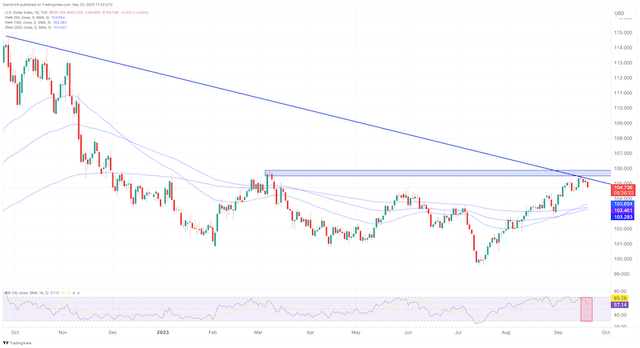
There are several reasons for the weakening dollar and rising inflation. Chief among them is the massive amount of new money creation in the past few years, along with rapidly rising debt (now at $33 Trillion!), deficits (up $1 trillion to $1.8 trillion this year), and exploding interest obligations on this debt (expected to hit $1 trillion this year). Adding pressure to the dollar is out-of-control government spending with no attempts at balancing the budget. The really concerning part of this picture is the rising interest cost on the debt, as interest rates have soared. To put it in perspective, the government is likely to spend more this year in interest expense on the debt than the entire defense department budget, which is already massively bloated at around $800 billion per year.
Interest expense on the debt (St Louis Fed)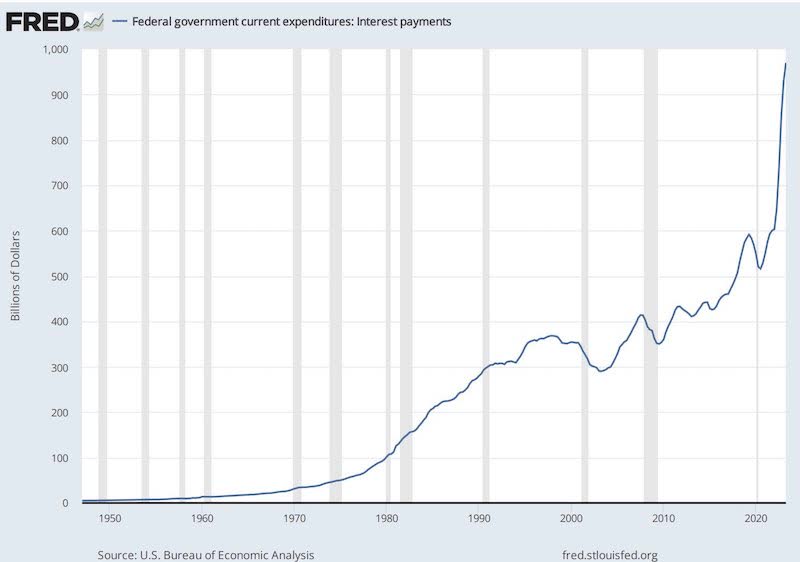
The national debt at $33 trillion is a full trillion higher than the $32 trillion it hit on June 15th. It took over 190 years to add the first $1 trillion to the national debt and the government just added the last trillion in three months!
The weaker dollar has led to prices for commodities climbing sharply and quality mining stocks generating substantial gains. Now that most of the rate hikes are behind us and we are at or near a terminal Fed Funds rate, we think the dollar decline will accelerate, which will translate into significantly higher commodity prices.
Increasing demand for metals used in electric vehicles, renewable energy applications and military hardware is also leading to elevated prices. Analysts expect this demand to continue to grow, with many metals likely facing supply gaps in the years ahead.
Conservative investors might want to opt for larger-cap names that are safer and less volatile or a diversified fund such as the VanEck Gold Miners ETF (GDX). For lithium exposure, there is the Global X Lithium & Battery Tech ETF (LIT), for copper exposure the Global X Copper Miners ETF (COPX), for rare earth exposure the VanEck Rare Earth/Strategic Metals ETF (REMX) and for uranium exposure the Global X Uranium ETF (URA). It is worth noting that these lithium, copper, rare earth, and uranium ETFs have outperformed gold and silver ETFs year-to-date in 2023.
Now that we have covered the safer and more diversified ways to invest in the mining sector, let’s examine a few speculative names that have a profile of higher risk, yet higher potential return.
TMC the metals company Inc. (NASDAQ:TMC)
TMC website
TMC the metals company Inc., a deep-sea minerals exploration company, focuses on the collection, processing, and refining of polymetallic nodules found on the seafloor in the Clarion Clipperton Zone in the south-west of San Diego, California. It primarily explores for nickel, cobalt, copper, and manganese products. This company is interesting because they are the only publicly-traded company focused solely on mining valuable metals from the seafloor.
They claim to be developing the world’s largest estimated source of battery metals, with enough nickel, copper, cobalt, and manganese to electrify the entire U.S. passenger vehicle fleet (Page 12 of latest corporate presentation). They estimate massive In situ quantities of nickel, copper, cobalt and manganese with a total resource of 15,700,000 t Ni / 2,400,000 t Co / 13,300,000 t Cu / 350,000,000 t Mn. Some nickel projects have high grade, some have a large resource, but TMC is an outlier among peers with the largest NiEq resource and highest NiEq grade.
TMC Corporate Presentation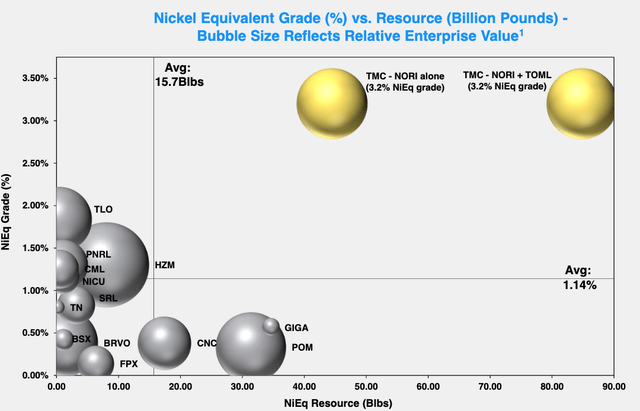
The company estimates an NPV of over $10 billion at current nickel prices, based on just 22% of the NORI-D resource. Yet the company is trading at an enterprise value of around $330 million.
TMC Corporate Presentation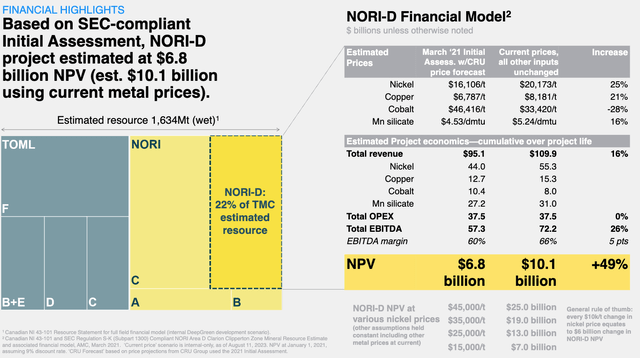
While most junior miners trade at a level much lower than their studies’ NPVs, this is a multiple of 10x to 20x less than their land-based peers. It implies huge upside should they be successful in obtaining permits to mine the ocean floor and moving into production.
On August 3rd, TMC said it plans to apply next year for a license to start mining in the Pacific Ocean, with production expected to start as early as late 2025. The company has
signed non-binding MoU with Pacific Metals Company (PAMCO) of Japan to evaluate the processing of 1.3 million tonnes per year of wet nodules But environmental campaigners say seabed mining could have a catastrophic impact on marine ecosystems, so it is still unclear if they will get the license needed to start mining. There are also questions around the costs to pull these nodules up from deep locations on the seafloor.
Polymetallic nodule on seafloor (TMC Website)
To deliver a high quality application for an exploitation contract, company executives told the market on August 1 that the company would need an incremental $60 million to $70 million cash on top of the existing cash balance. This does not yet include any drawdown on the existing $25 million Allseas unsecured credit facility that was extended through November of 2024.
Q2 financials included a net loss of $14.1 million and total cash of approximately $20.0 million as of June 30, 2023. The company has no debt. They announced a Registered Direct Offering at a price of $2.00, a premium of 82% to the TMC closing share price on August 11, with expected gross proceeds of approximately $27 million.
TMC leadership believes that cash on hand, the expected net proceeds from the registered direct offering and borrowing availability under our recently amended and extended credit facility will be sufficient to meet working capital and expenditure commitments for at least the next eleven months.
TMC is an interesting speculative mining play. Management believes it has rights to the globe’s largest undeveloped nickel project. Nickel is one of the most widely used minerals for EV batteries and will see increased demand in the years ahead. A supply gap is likely to push prices for nickel much higher in the years ahead, potentially increasing the value of TMC as well. Much will hinge on getting final regulations from the International Seabed Authority, which seems to be in no hurry with this process. But if it happens and TMC gets permits, I think this stock could easily soar 5x or more from current levels.
The share price spiked higher on increased media coverage lately, but dropped back just as fast. I recommend this balanced article from CNBC for continued reading on TMC. The price went from 65 cents to $3.00, before falling back to $1.06 currently. A small allocation as a lottery ticket could be of interest for risk-tolerant investors.
TradingView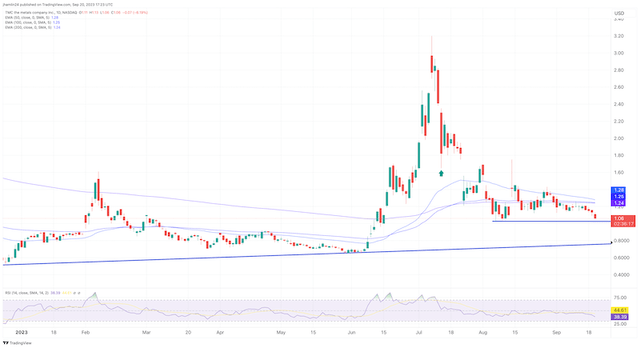
Texas Mineral Resources Corp (OTCQB:TMRC)
TMRC website
Texas Mineral Resources Corp.’s primary focus is to develop and commercialize, along with its joint venture operating partner USA Rare Earth LLC, the Round Top heavy-rare earth, technology metals, and industrial minerals project located in Texas. TMRC owns an approximate 20% interest and USA Rare Earth owns an approximate 80% interest. Additionally, the company is having some success exploring for silver in New Mexico.
The 2019 preliminary economic assessment (PEA) on Round Top was very encouraging with a pre-tax NPV of $1.5 billion and internal rate of return (IRR) of 79%. With a 20% interest, TMRC’s ownership of this NPV is approximately $300 million, yet they have a market cap of just $68 million.
Junior miners typically have an NPV that is much higher than their market cap, but rarely generate an IRR this high. An IRR anywhere above 20% is typically considered good in the mining industry, so this IRR of 79% is outstanding, albeit still very preliminary in nature. The mine life is 20 years based on just 14% of the existing mineral resource estimate.
What I find particularly interesting about TMRC at the current time is that Round Top hosts the largest known gallium deposit in the United States at 36,500 metric tons.
Gallium is a rare mineral that only occurs in trace amounts as a by-product of mining and processing other metals, such as aluminum, zinc, and copper. Gallium arsenide has a similar structure to silicon and is a useful silicon substitute for the electronics industry. It is an important component of many semiconductors. It is also used in red LEDs (light emitting diodes) because of its ability to convert electricity to light. Solar panels on the Mars Exploration Rover contained gallium arsenide. Gallium nitride is also a semiconductor. It has particular properties that make it very versatile. It has important uses in Blu-ray technology, mobile phones, blue and green LEDs and pressure sensors for touch switches. Gallium readily alloys with most metals. It is particularly used in low-melting alloys. It has a high boiling point, which makes it ideal for recording temperatures that would vaporize a standard thermometer. Gallium is on a short list of critical minerals published in the Federal Register.
China, the world’s top supplier of the two minor metals used to make semiconductors, announced restrictions on the exports of eight gallium and six germanium products in early July, citing national security reasons.
This is a decision that many consider a retaliation for restrictions imposed on the Chinese semiconductor sector by the U.S., Japan, and the Netherlands in recent quarters. China’s export controls on gallium and germanium kicked in last week, with traders braced for a drop in international supply in August and September. Stockpiles outside China, which could last for two to three months, will need to be tapped while traders await Beijing’s export permit approvals.
China has also banned export of germanium, which is also used to manufacture microprocessors, but also solar cells and vision goggles used by the military. But I view gallium as the more important of these two metals. The U.S. and western governments have stockpiles of germanium but not gallium. Also, China controls 60% of germanium, but 80% of the global supply of gallium.
China’s exports of germanium and gallium products in August plunged, customs data showed on Wednesday. China exported no wrought germanium products last month, compared to 8.63 metric tons in July when volumes more than doubled from June as overseas buyers rushed to lock in supply ahead of the curbs. There were also no exports of wrought gallium products in August. In July, exports were 5.15 tons and 7.67 tons in the same month in 2022, the data showed.
Offer prices for gallium ingot at Rotterdam jumped 43.4% to $370 per kg last week, against $258 per kg in late June.
Again, TMRC’s Round Top project is estimated to have the largest known deposit of gallium in the U.S. Round Top has around 20 different rare earth metals, with a favorable composition toward the more valuable heavy rare earth metals such as Dysprosium, Lutetium, Terbium, Neodymium, etc. Round Top also contains lithium, uranium, and several industrial minerals.
This deposit has key minerals that are used in several vital applications including defense, consumer technology and green energy. With geopolitical tensions and economic warfare heating up between the U.S. and China/Russia, it is more important than ever that the U.S. secures domestic supplies of these metals. This is why I think the value of the Round Top project could increase dramatically and the government may step in with grants and other incentives to move the project toward production.
Round Top Deposit (TMRC website)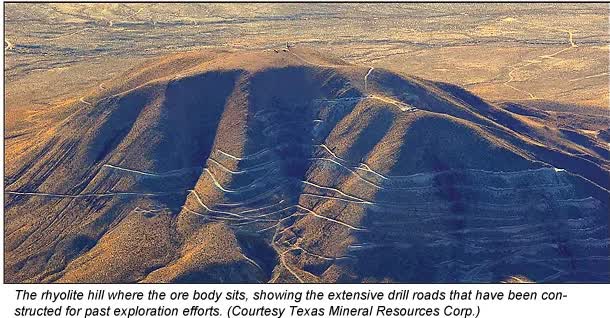
TMRC has also signed a mineral exploration and option agreement with Santa Fe Gold with an initial target silver property within the Black Hawk Mining District in New Mexico. The geology is generally characterized by narrow ultra-high grade silver veins. A bankable feasibility study is to be conducted in measured phases and TMRC has established a new Standard Silver subsidiary to hold these project assets.
During July they reported the successful completion of a geophysical investigation using multiple variations of EM (electro-magnetic) geophysical surveying within the Black Hawk mining district, Grant County, New Mexico. They identified 16 potential drill targets. While this is still early stage exploration of historic mining areas, it nonetheless gives investors potential exposure to silver, in addition to the rare earths and lithium at Round Top.
The company’s management/board owns an estimated 20% of outstanding shares, aligning their interests with those of shareholders.
In terms of risks, the project has been in the PEA phase for over 3 years now with no signs of progressing toward development. TMRC seems to be focusing on silver exploration in New Mexico and their partner seems focused on a rare earth metal and sintered neo-magnet plant in Oklahoma. This facility could have significant synergies with Round Top, but they don’t seem to be deploying capital toward Round Top itself.
Another risk is that TMRC has very little cash on hand, which means shareholder dilution could be incoming. The latest quarterly 10-Q report from July showed just $1.3 million in cash on hand, down from $1.5 million in April. At this pace, they will need to raise additional funds within roughly 6 months.
But a recent press release highlights the option for TMRC to meet cash needs by reducing their equity interest in the project, rather than issuing new shares.
I spoke to the chairman, Anthony Marchese, who confirmed they view giving up a little more equity interest as a better option to shareholder dilution. He also shared the following:
– TMRC is waiting on USA Rare Earths to take next step of the PFS.
– They promised the PFS too soon, but it is currently underway and will be key to unlocking additional financing. A full feasibility study is expected to follow.
– The PEA released is just on the first 20 years of production, but they expect Round Top could produce for up to 100 years.
– Hatch signed a strategic agreement and invested in USA Rare Earth, which is rare for an engineering firm and shows their conviction in the projects.
– Round Top will supply battery metals to the magnet plant that USA Rare Earth is building in Oklahoma. Production is expected to start in 2024.
– The licensing pathway is favorable as Round Top is on Texas state property and not federal property.
– While Round Top has the largest gallium deposit in North America, it will likely not be economic to access all of it. The focus will be on how to maximize the profitability per tonne mined.
– Marchese is highly enthusiastic about the prospects of their silver exploration in the Blackhawk mining district of New Mexico and believes it could produce a an NPV even larger than their $300 million NPV stake in Round Top.
The upshot for TMRC and shareholders would be government funding, a takeover of their interest in Round Top at an attractive valuation, or a partnership with a larger mining company such as MP Materials. The financials look compelling and securing supplies of gallium is of critical strategic importance with China banning exports.
Insiders have bought shares in the open market recently, although a small amount, and former Secretary of State Mike Pompeo has joined the partner company USA Rare Earths as a strategic advisor.
And if the drilling they hope to do in New Mexico is as compelling as the initial results from the electro-magnetic geophysical surveying, this project could be worth more than TMRC’s stake in Round Top.
I view TMRC as a risky investment, but one that could generate significant returns for investors willing to take a position early.
The share price for TMRC has dipped to the lowest levels since early 2020. The share price bounced from $0.75 cents to over $1.00 in May and then bounced again from $0.80 cents to a brief high near $1.40 in July on the China export ban announcement. Those were moves of 34% and 75% in just a few days. The price has since dropped back to $0.55 and could be offering an attractive entry price for risk-tolerant investors as it dips to past support.
TradingView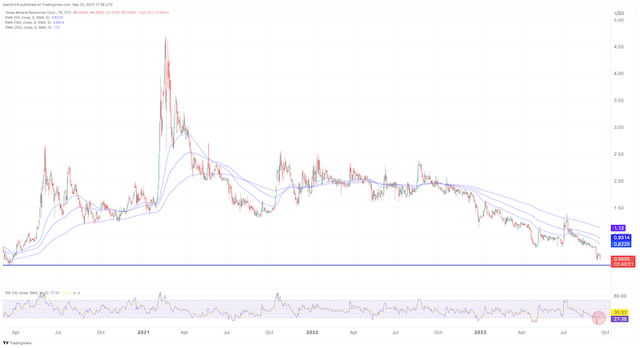
Editor’s Note: This article discusses one or more securities that do not trade on a major U.S. exchange. Please be aware of the risks associated with these stocks.
Read the full article here












